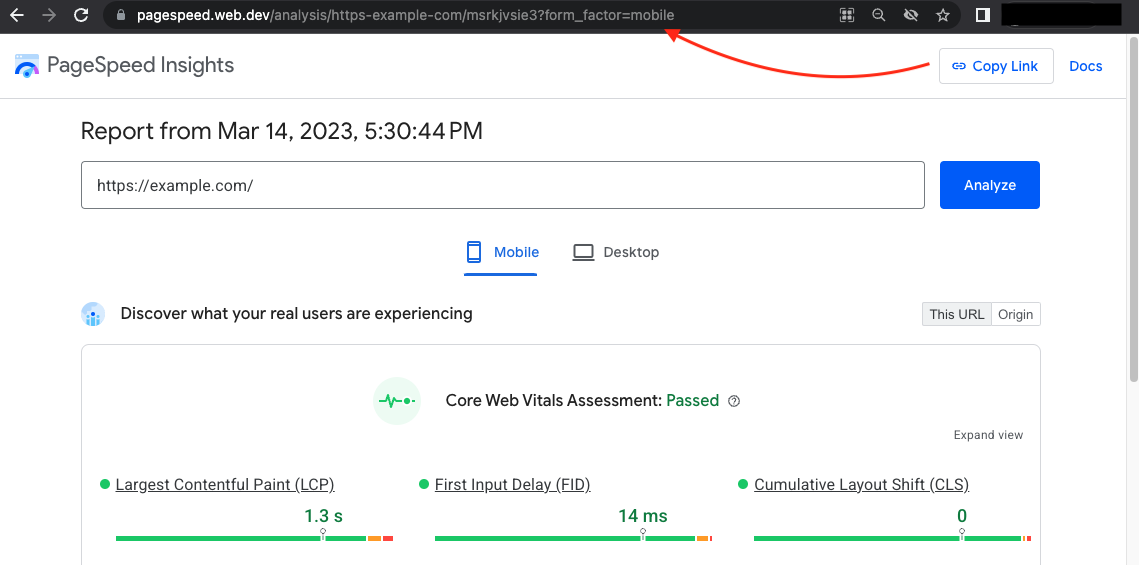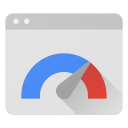Page Summary
-
PageSpeed Insights utilizes Lighthouse for analysis and incorporates field data from the Chrome User Experience Report (CrUX).
-
The API and UI have undergone updates, including the addition of new metrics like Interaction to Next Paint (INP) and Time to First Byte (TTFB), and adjustments to CPU throttling.
-
Lighthouse versions are updated independently, resulting in occasional breaking changes to the API response and the introduction of new audits and categories.
-
Shareable links for analysis reports are now available in the UI, providing snapshots of results for up to 30 days.
-
Previous versions of the PageSpeed Insights API (v1-v4) have been deprecated, with v5 being the current and recommended version.
Release notes for PageSpeed Insights API and PageSpeed Insights UI
Note: The API is versioned as v5, however the Lighthouse version is independent and updated regularly.
Oct 20, 2025
As of Oct 20, 2025, PageSpeed Insights and the API have been updated to Lighthouse 13.0.
Dec 5, 2024
The CPU throttling factor for PageSpeed Insights has been adjusted to account for the low CPU performance benchmarks typical in PageSpeed Insights production environments. In general, this should result in increased lab data TBT scores for sites on mobile. Field data and desktop scores should not be affected.
May 10, 2024
As of May 10, 2024, PageSpeed Insights and the API have been updated to Lighthouse 12.0. Please be aware that there are some breaking changes in the API response, including the removal of the PWA category.
Aug 28, 2023
As of Aug 9, 2023, PageSpeed Insights and the API have been updated to Lighthouse 11.0. Please be aware that there are some breaking changes in the API response.
The Lighthouse 11 blog post describes the notable changes, including updates to the Accessibility category and existing audits.
Aug 8, 2023
As referenced in the previous release note,
EXPERIMENTAL_INTERACTION_TO_NEXT_PAINT is no longer in the API response.
INTERACTION_TO_NEXT_PAINT has the same data, and should be used for the page's
field INP.
May 10, 2023
Interaction to Next Paint (INP) is no longer an experimental metric, and is now a pending Core Web Vital. This change is reflected in UI and API.
For the API specifically, the response now has metric INTERACTION_TO_NEXT_PAINT,
which contains the same data as EXPERIMENTAL_INTERACTION_TO_NEXT_PAINT.
EXPERIMENTAL_INTERACTION_TO_NEXT_PAINT will be removed from the response in 90 days
(August 8, 2023).
March 16, 2023
Announcing a new feature in the UI: shareable links! Now, analyzing a URL will take you to a
new /analysis path, with a unique identifier in the link.

This page contains a shareable snapshot of the report, with a timestamp at the top that denotes
the time of analysis. Clicking the "Copy Link" button copies the link to your clipboard, which
is shareable for 30 days after creation. Note that the previous /report path will
redirect to the analogous /analysis path.
March 14, 2023
PageSpeed Insights and the API have been updated from Lighthouse 9.6.x to
Lighthouse 10.0.x.
There are some breaking changes in the API response,
including a new location for full-page-screenshot and updated Url properties.
The Lighthouse 10 blog post describes the notable changes, including scoring.
Oct 27, 2022
The UI now has more Lighthouse categories in the lab data section, in addition to Performance. The added categories are Accessibility, Best Practices, and SEO. See Lighthouse documentation for details about these categories and their respective audits.
May 10, 2022
Introducing two new experimental field metrics to both the API and UI: Interaction to Next Paint (INP) and Time to First Byte (TTFB). These field metrics are currently experimental, but are now available for users to try out. Experimental metrics may change or disappear.
The UI has a new loading experience as well. Changes include:
- Field and lab data load in parallel, so you’ll see results sooner.
- PSI will attempt to resolve HTTP redirects before analysis. Before, PSI would send the URL directly to Lighthouse and Lighthouse would handle redirects. Now, PSI will attempt to follow 3XX redirects before handing off that URL to Lighthouse. It is still possible to opt to run with the "original" URL, but this is not usually advised.
- The Core Web Vitals (CWV) metrics (LCP, FID, CLS) appear directly underneath the CWV assessment.
- We tightened the design, reducing verbosity and vertical space.
Feb 17, 2022
PageSpeed Insights is now using Lighthouse 9.3.0. See the complete 9.3.0 release notes.
Nov 15, 2021
PageSpeed Insights UI has a new look and home. Check it out! See the associated blog post for more information.
Also, as of Nov 13, 2021, PageSpeed Insights is now using Lighthouse 9.0.0. See the complete 9.0.0 release notes and read through the notable changes.
Sept 22, 2021
PageSpeed Insights is now using Lighthouse 8.4.0. See the complete 8.4.0 release notes.
Aug 31, 2021
PageSpeed Insights is now using Lighthouse 8.3.0. See the complete 8.3.0 release notes, along with the 8.2.0 and 8.1.0 release notes.
June 10, 2021
PageSpeed Insights field data is now provided for pages and origins that might have insufficient
data for a metric, but sufficient data for other metrics. Previously, field data was only
surfaced if all metrics for a page or origin met a threshold of data. Now, any metric that meets
the data threshold will be provided. This is reflected in the loadingExperience and
originLoadingExperience objects in the API, and also in the frontend. See the
docs
for how this relates to the Core Web Vitals assessment.
June 1, 2021
PageSpeed Insights is using Lighthouse 8.0.0. See the complete 8.0.0 release notes and read through the Notable changes. If you use the API, consider the Breaking changes for programmatic users.
The CrUX API (which underpins PSI's field data section) has been updated, see their release notes.
May 24, 2021
Pagespeed's underlying Chrome instance was upgraded from Chrome 88 to Chrome 90. This wouldn't be very observable, except for possible impact of a few improvements to CLS that were part of 89 and 90.
April 1, 2021
Lighthouse 7.3.0 was deployed to PageSpeed Insights on April 1, 2021. See the complete 7.3.0 release notes.
March 3, 2021
As of March 3, 2021, PageSpeed Insights uses http/2 to make network requests, if the server supports it. Previously, all requests were made with http/1.1 due to constraints in connectivity infrastructure. With this improvement, you can expect more similarity between Lighthouse results from PSI and from Lighthouse CLI and DevTools (which have always made requests with h2). However, it's important to keep in mind that different environments (hardware & connectivity) will influence measurement, so cross-environment consistency is near impossible.
With this change, network connections are often established quicker. Given your requests are served in h2, you can likely expect metrics and the performance score to improve. In general, performance scores across all PageSpeed Insights runs went up by a few points.
If your page does not support h2, the report will now show an audit that estimates the performance improvement if the page were to support h2.
March 2, 2021
As of March 2, 2021, the max timeout of the PSI API was raised from 60s to 120s. Complex and heavy web pages can take longer to analyze, and many would time out. We've relaxed our timeouts to give these heavyweight pages a better chance of getting results.
February 19, 2021
As of February 19, 2021, PageSpeed Insights is using Lighthouse 7.1.0. See the complete 7.0.0 release notes and read through the Notable changes. If you use the API, consider the Breaking changes for programmatic users. As this is an upgrade since 6.3.0, it includes the major v7 release, along with 6.4.0, 6.5.0 and 7.1.0 releases. You may see runs taking slightly longer for heavy pages. You shouldn't expect significantly different performance scores, though small metric adjustments are due to bug fixes in the analysis and metric implementations.
December 3, 2020
As of December 3, 2020, PageSpeed Insights is using the Chrome User Experience Report (CrUX) API to get field data. In the API, this affects the loadingExperience and originLoadingExperience objects. More information on the change can be found here.
Sept 8, 2020
Lighthouse 6.3.0 was deployed to PageSpeed Insights on Sept 8, 2020.
May 27, 2020
Lighthouse 6.0.0 was deployed to PageSpeed Insights on May 27, 2020.
May 2020
v1, v2, v3beta1, and v4 of the PageSpeed Insights API were removed in May 2020. Here are some deprecated in Nov 2018. See here for migration suggestions.
May 7, 2019
Lighthouse released 5.0 on May 7, 2019. Information on changes can be found here: Lighthouse 5.0 + PSI Release Notes
January 31, 2019
Lighthouse (which powers PageSpeed Insights) released v4.1 on January 31, 2019. Information on changes can be found here: Lighthouse 4.1 Release Notes
November 2018
v5 of the PageSpeed Insights API was released in November 2018. It now uses Lighthouse as its analysis engine and also incorporates field data provided by the Chrome User Experience Report (CrUX). v5 of the API will now provide CrUX data and all of the Lighthouse audits. Previous versions of the PSI API will be deprecated in six months.
Historical API Versions
Version 4
v4 of the PageSpeed Insights API was released in January 2018. It adds a speed score based on Chrome User Experience Report and refines the original PSI score as a new optimization score which mainly focuses on the relative headroom to improve.
Version 2
v2 of the PageSpeed Insights API was released in January 2015. It adds support for rule groups, such as 'SPEED' or 'USABILITY'.
Updates after release:
- Result category was added on May 12th, 2017.
- Render engine was switched from Webkit to Blink on February 2nd, 2017.
- Image optimization library was switched to use the one in mod_pagespeed on December 12th, 2016.
- The app-install interstitial rule was removed from score computation in both API versions on August 23th, 2016. The rule was removed completely on November 1st, 2016.
Deprecated. Will close on Jun 2018.
Version 1
The initial version of the API. This release includes support for localization in 40 languages.
On October 29, 2013, the ruleScore field, which has been deprecated in PageSpeed Insights for over a year, was removed from the API. We recommend that clients use the ruleImpact field instead.
Closed.
